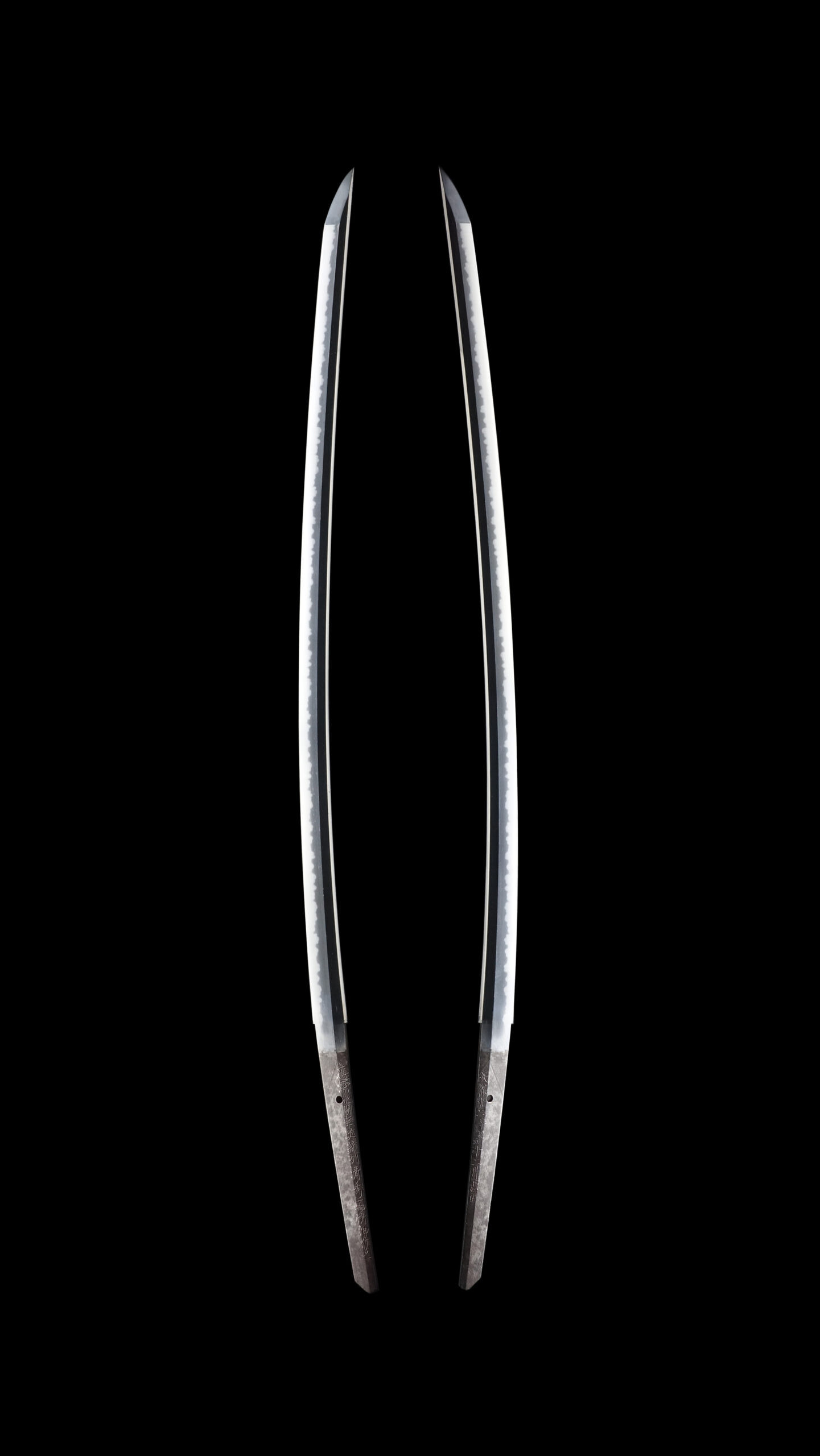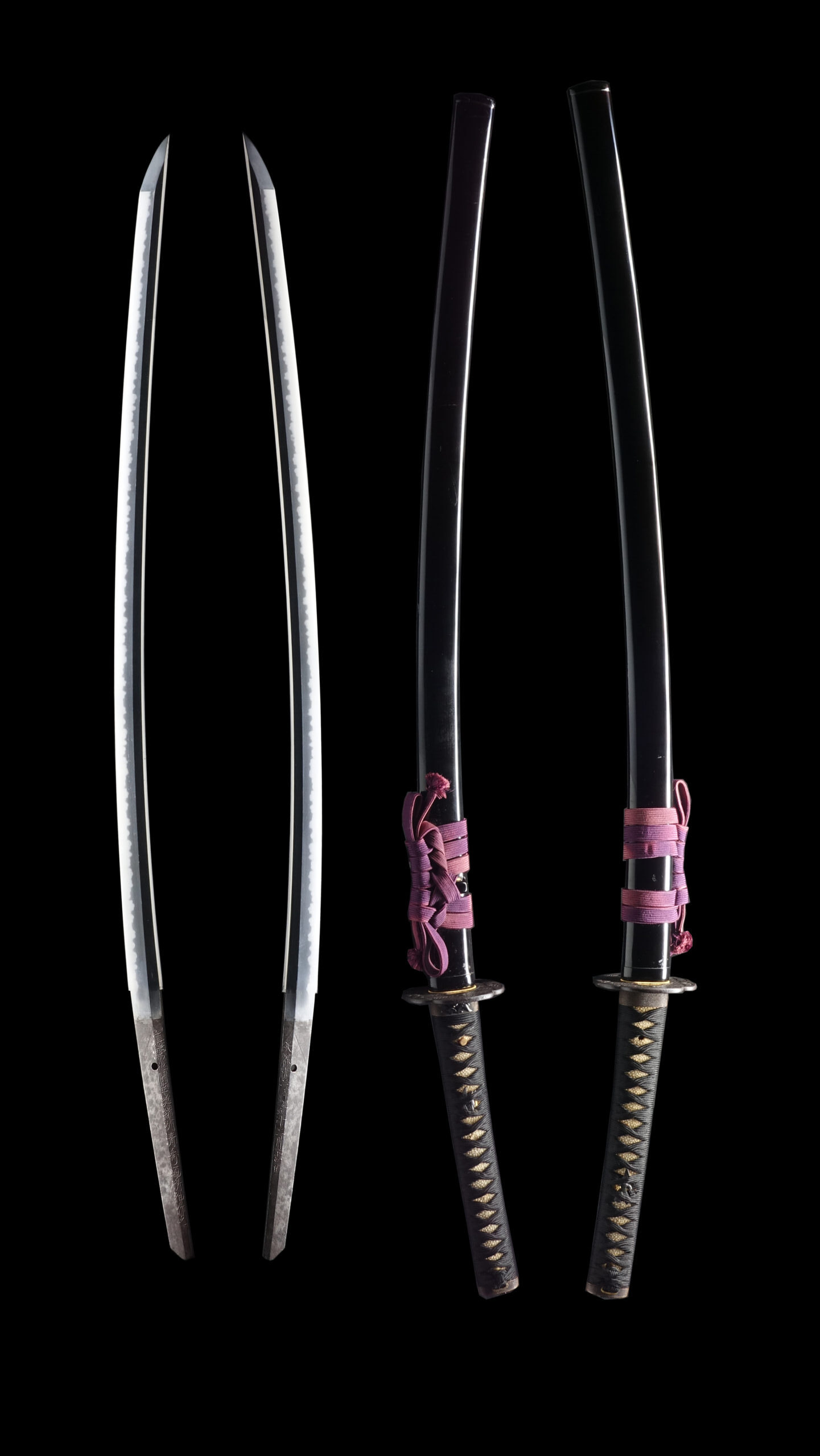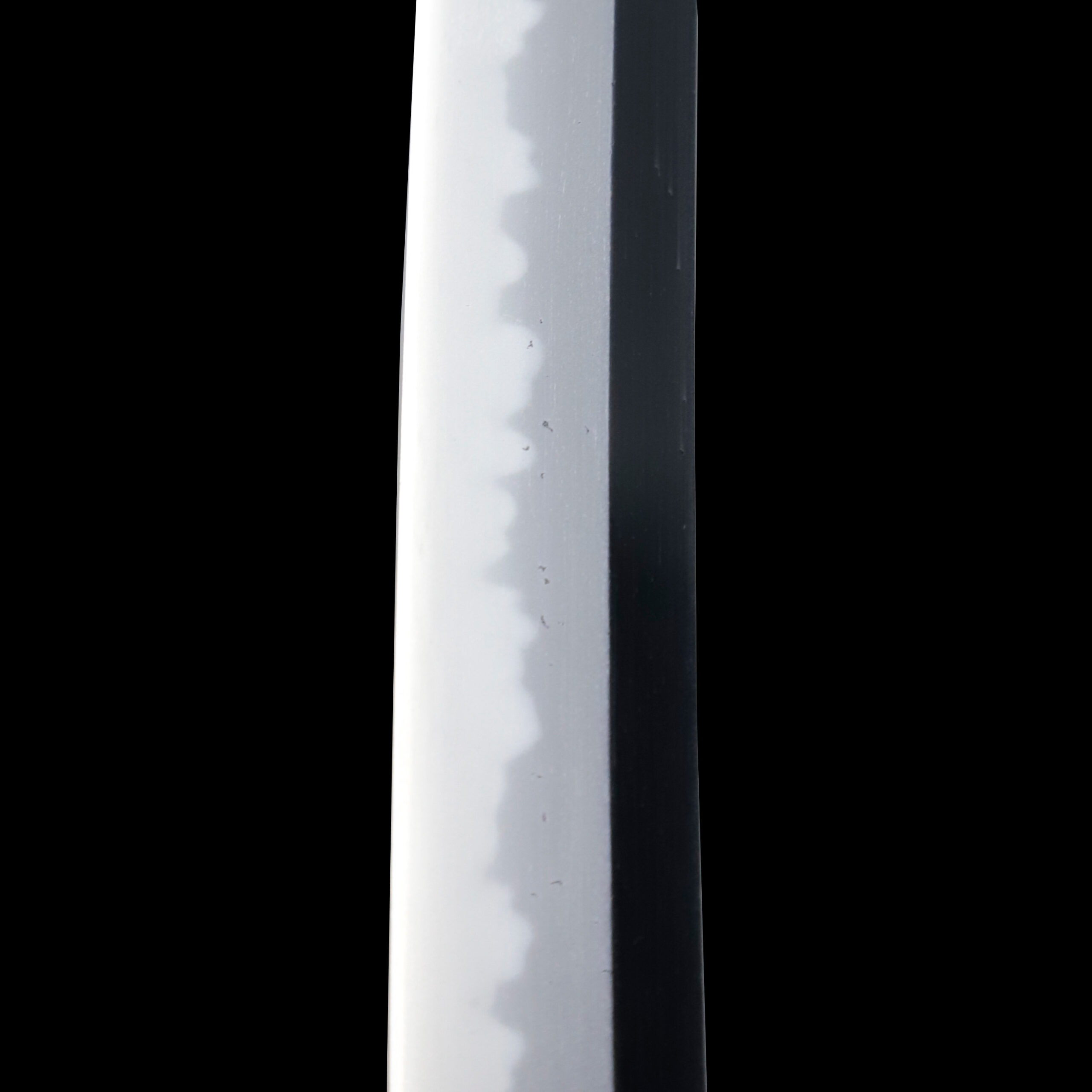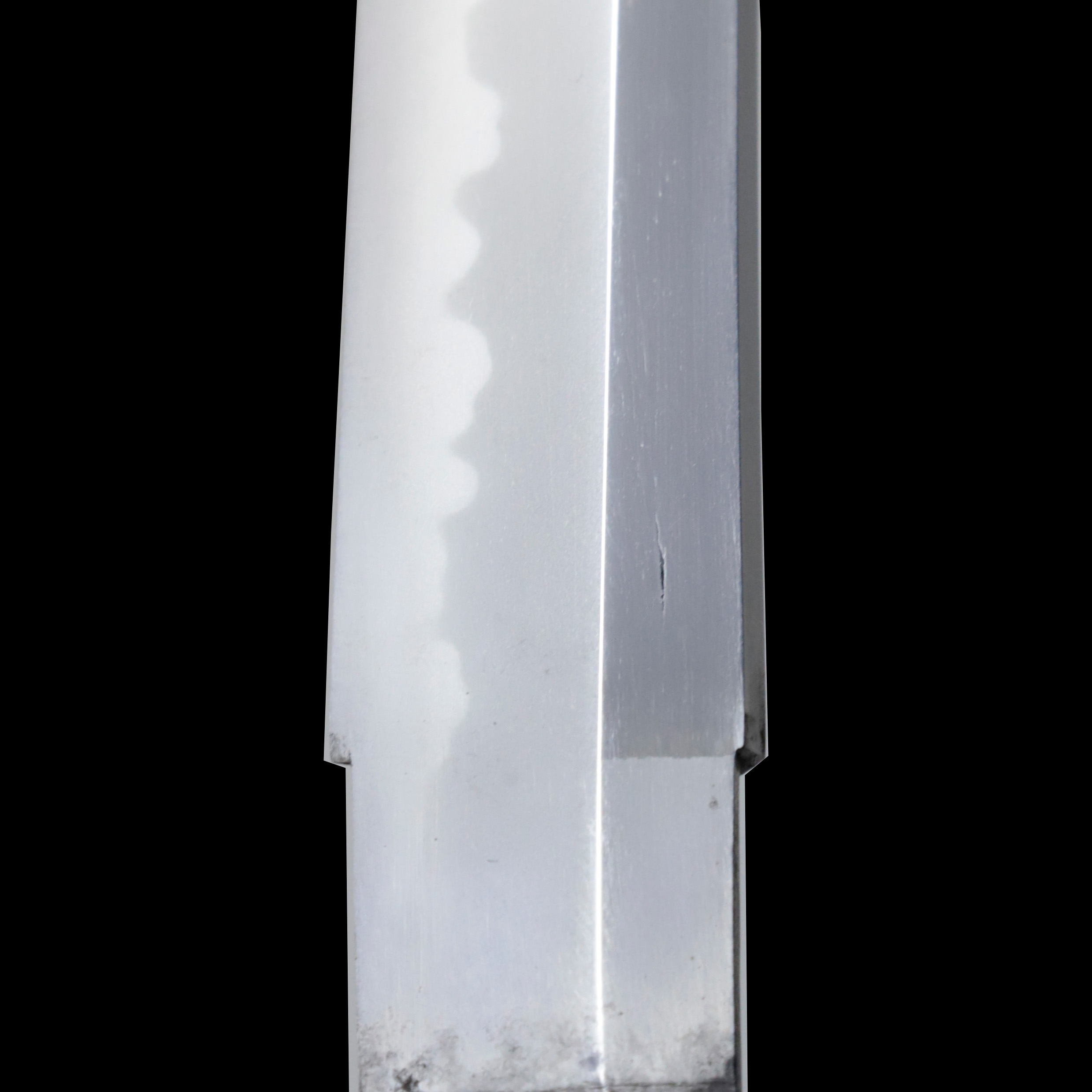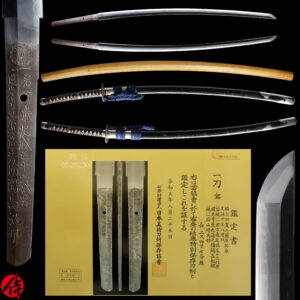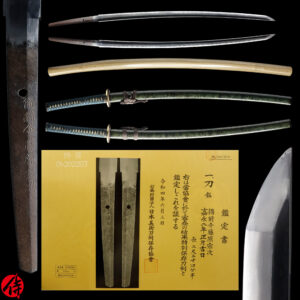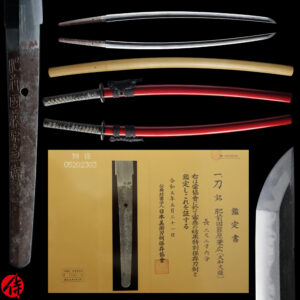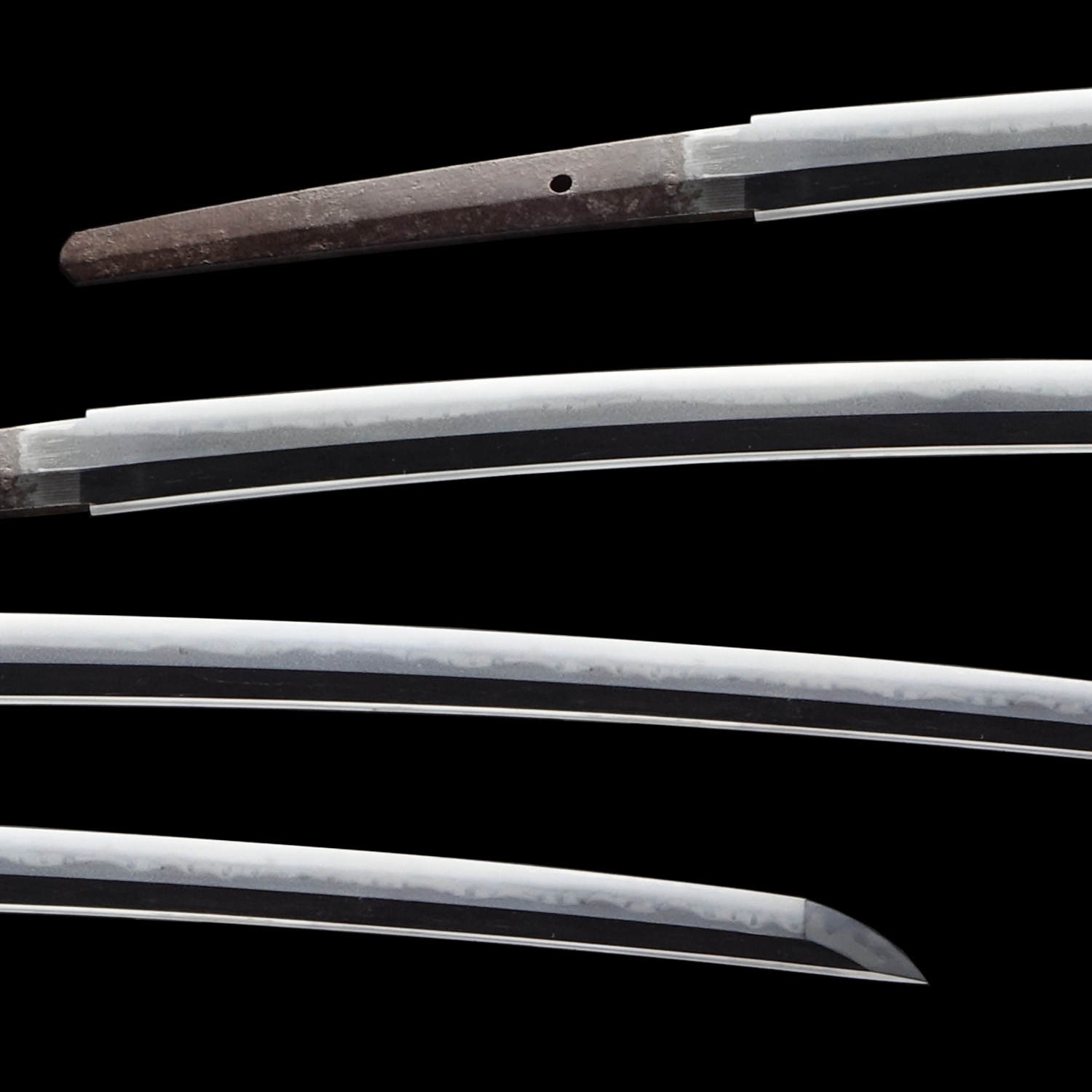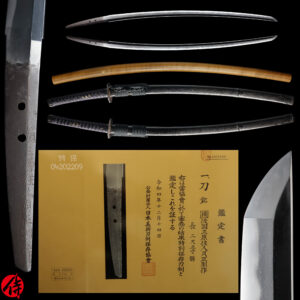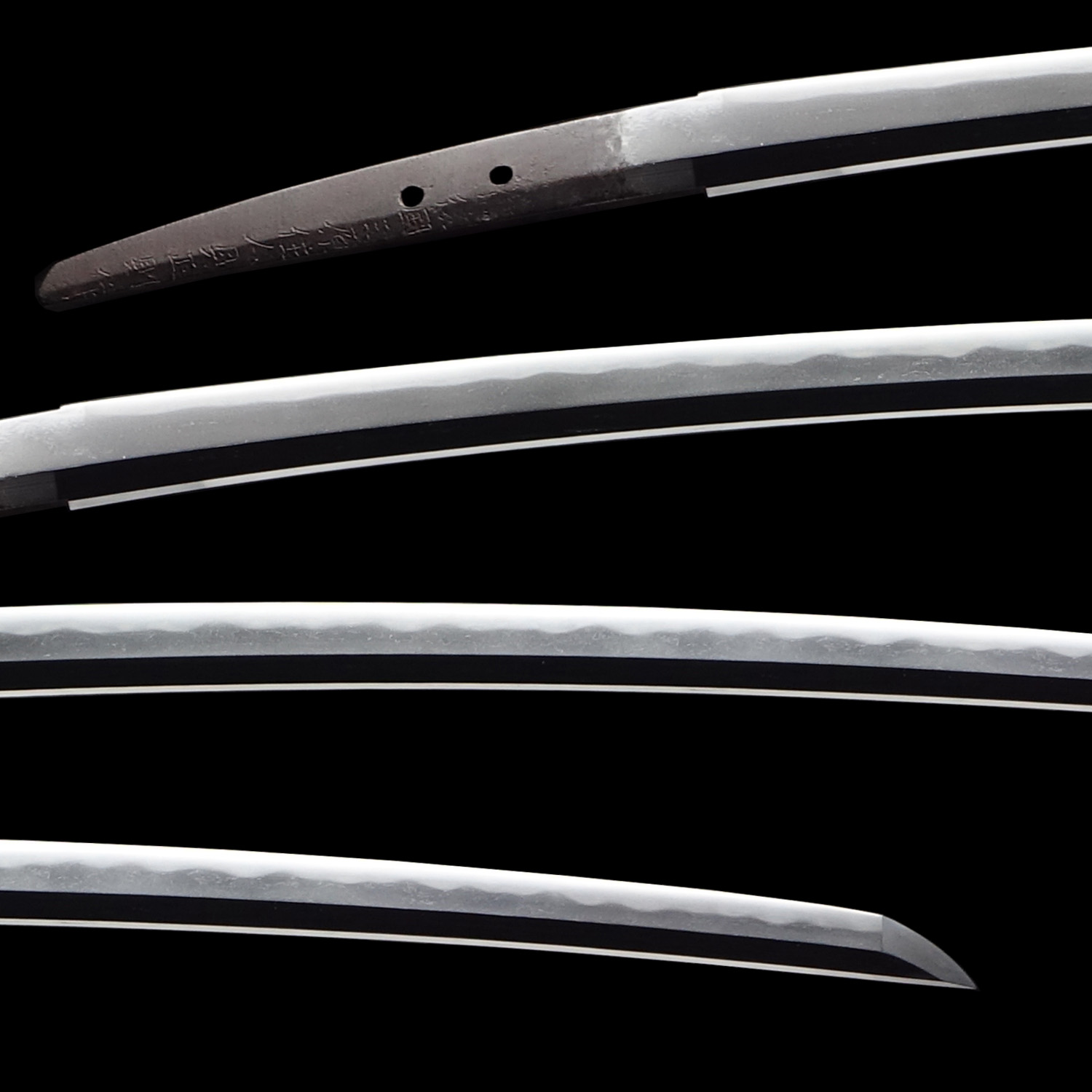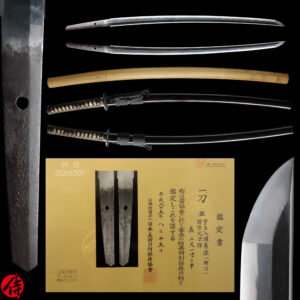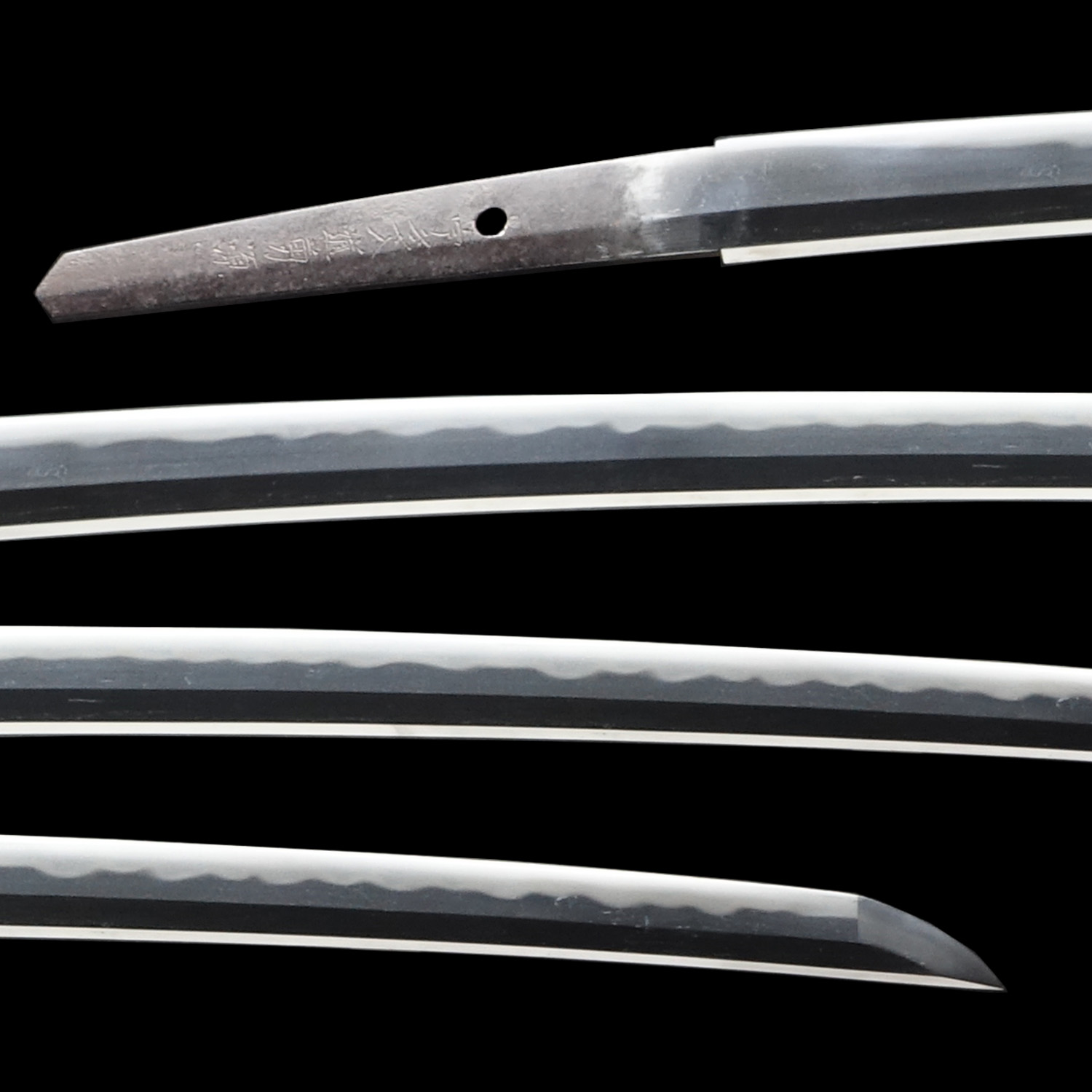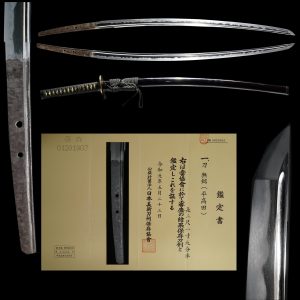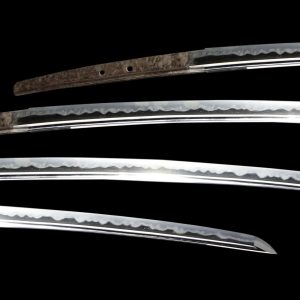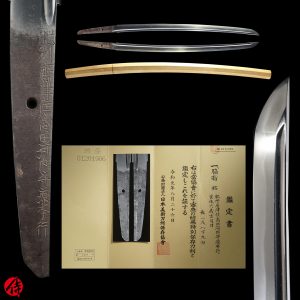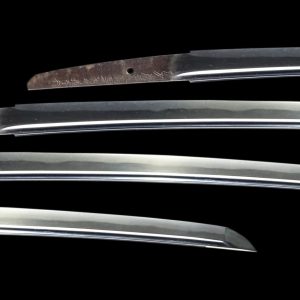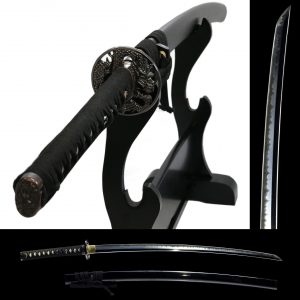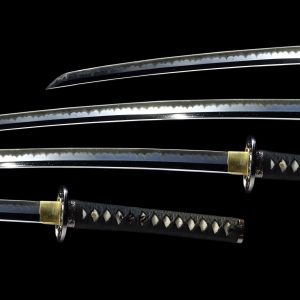Antique Japanese Sword Katana Signed by Kiyohide with Tokubetsu Hozon Certificate
【Description】
This blade was signed by Chikushu Kiyohide (筑州清秀) in the 12th year of the Tenpo era (1841). The signature says that it was ordered by Mizuma Yukihide(水間幸英). When you find the orderer’s name in the signature, it is called Chumon Uchi. We assume this man was a high-rank Samurai official who served Arima clan in Chikushu province (Today’s Fukuoka prefecture).
Kiyohide’s birthname was Aoki Seibe. He was an apprentice of Aoki Kiyohiro. Kiyohide served the Arima clan, the head of the Kurume domain in Chikushu province, as an Okakaekaji, who exclusively served this domain. It was honorable for any swordsmith to be in this position. He was especially active during 1834-1844 (Tenpo era: The end of the Edo period). In 1845, he received the honorable official title of Omi no Suke (近江助) from the imperial court for his excellent craftsmanship. In Chikugo province, a few swordsmiths used Kiyo (清) in their maker’s name, such as Kiyohiro, Kiyotsuna, and Kiyotsune.
Kiyohide was excellent at forging blades with Choji Midare Hamon, which is the characteristic of the Bizen sword-forging style (BIZEN DEN). Choji Midare Hamon is an Irregular, wavy tempering line. One theory says that Kiyohide might have learned this excellent technique from Bizen Sukenaga (備前祐永), one of the most famous swordsmiths in Bizen province at the end of the Edo period.
It is appraised as a Tokubetsu Hozon Token (特別保存刀剣) issued by NBTHK (Nihon Bijutsu Touken Hozon Kyokai: 日本美術刀剣保存協会). This authentication paper was only given to authentic Japanese swords, especially well preserved and high quality with artistic value.
*Please keep in mind that there are a couple of minor black rust and Kitae Kizu on this blade. If you like to know the detailed condition, please feel free to contact us.
【 Blade】
Cutting Edge Length(Nagasa): 67.6 cm (26.6 inches)
Curvature(Sori): 1.8 cm (0.71 inches)


Hamon:
the crystalline structure which forms along the cutting edge of a blade as a result of the hardening process
Jimon (Jihada):
visible steel surface pattern created by folding and hammering during forging process
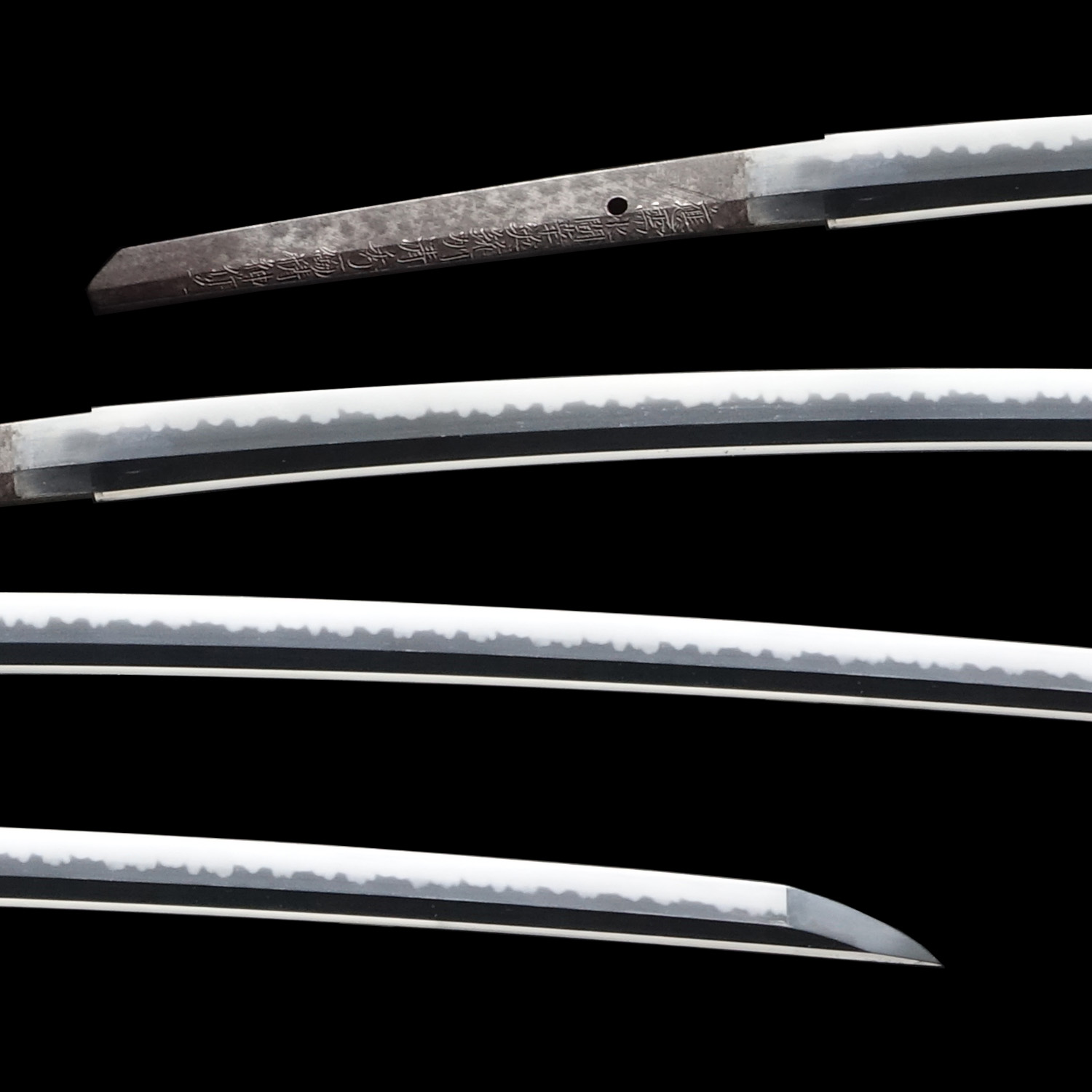
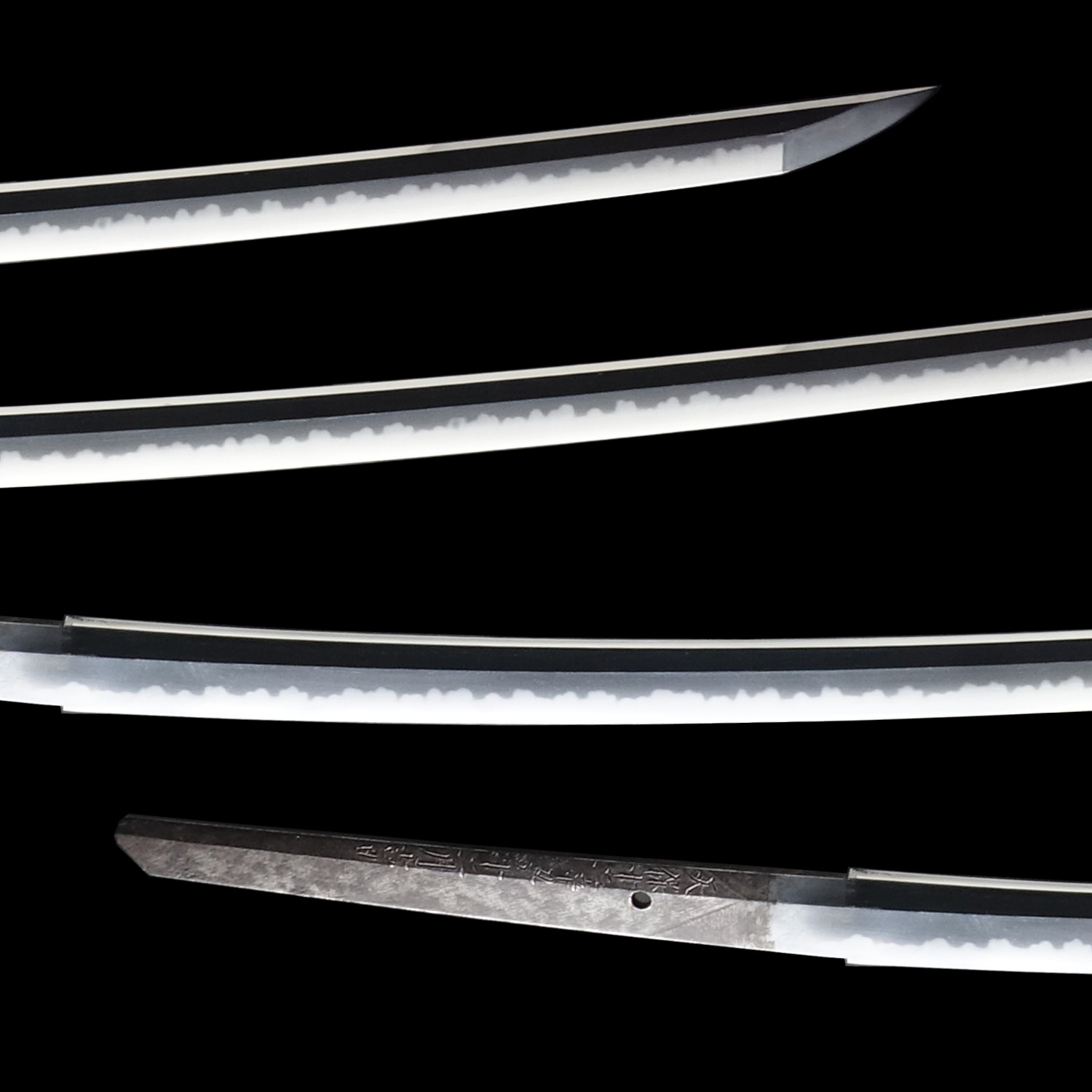

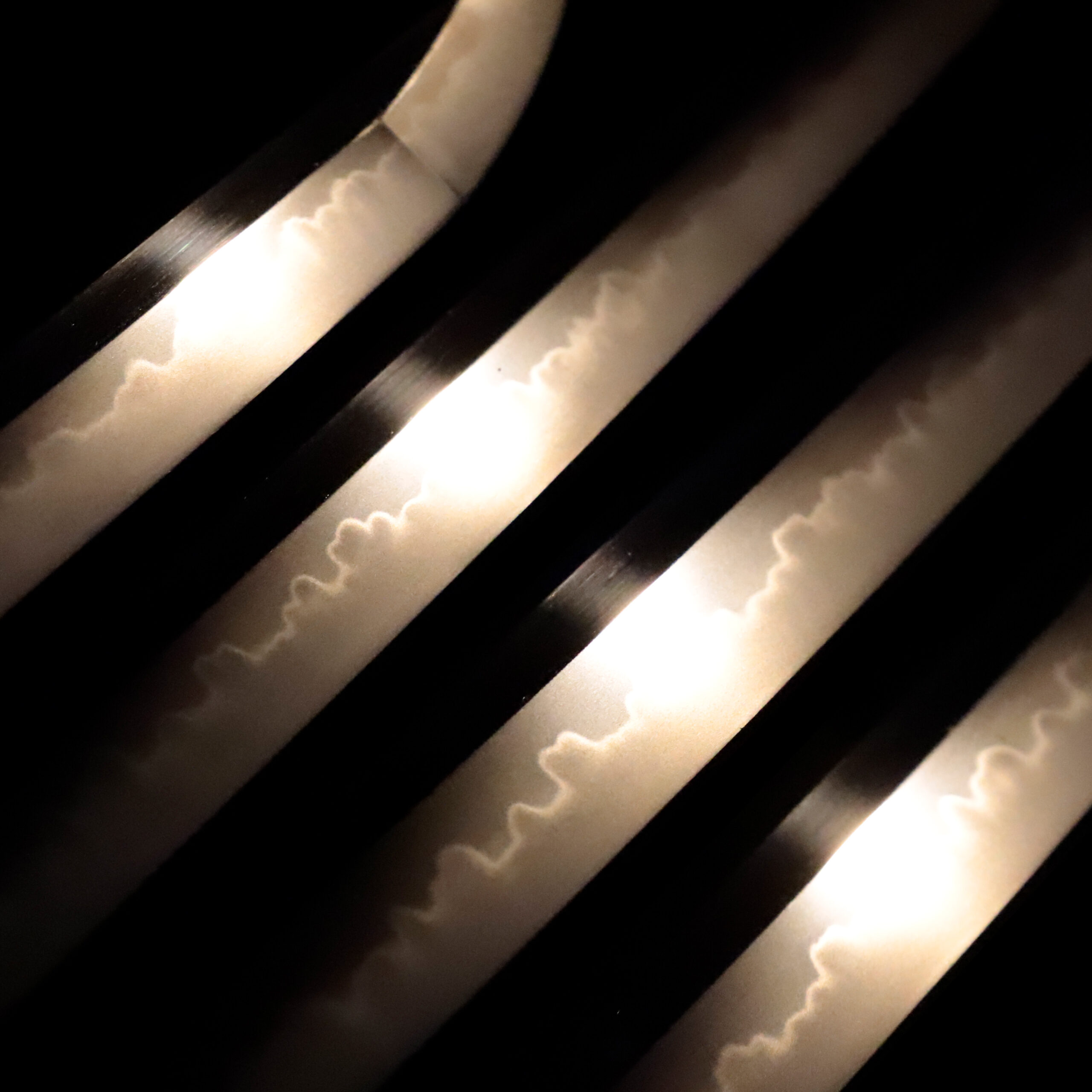
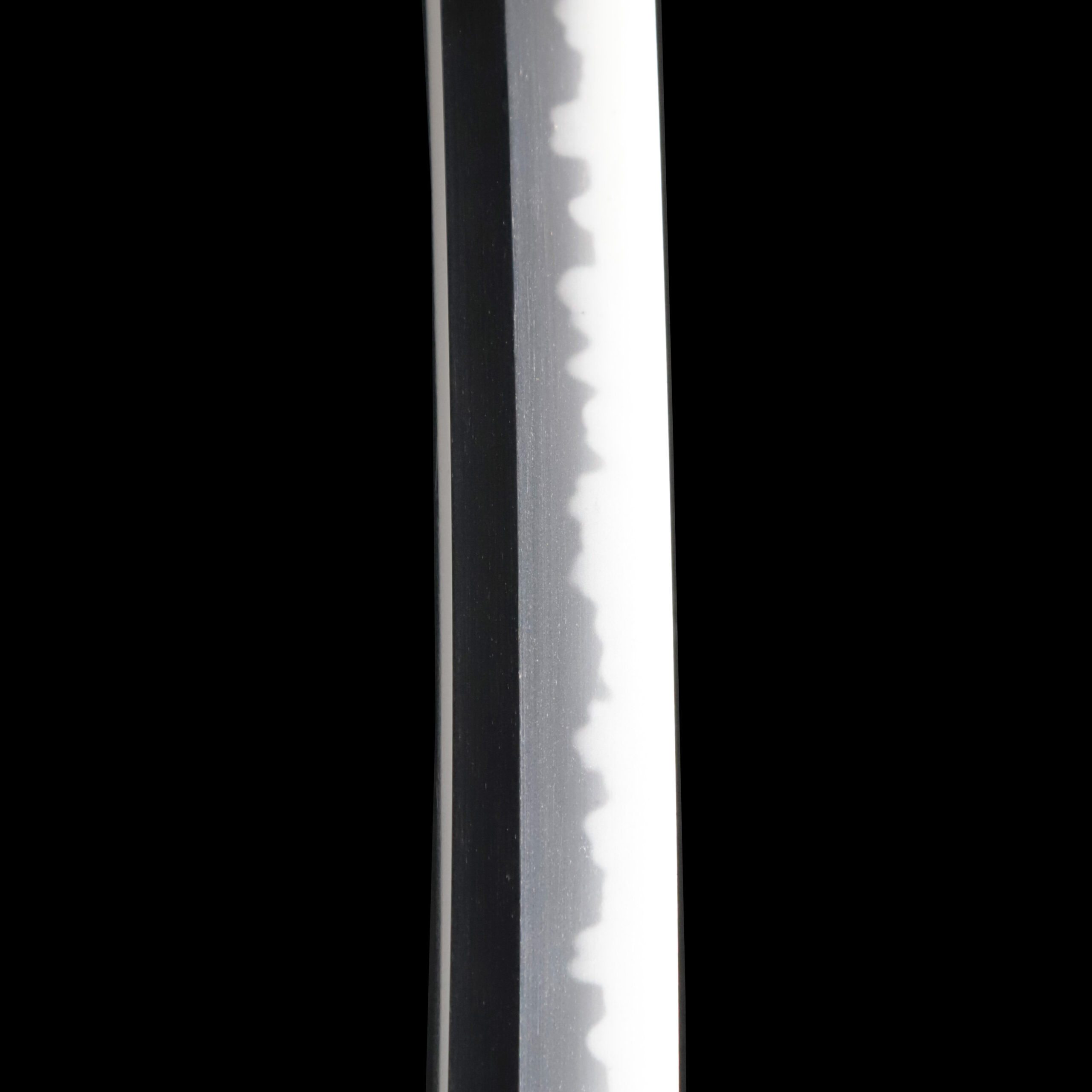

Kissaki: Kissaki is the tip of the Japanese sword.
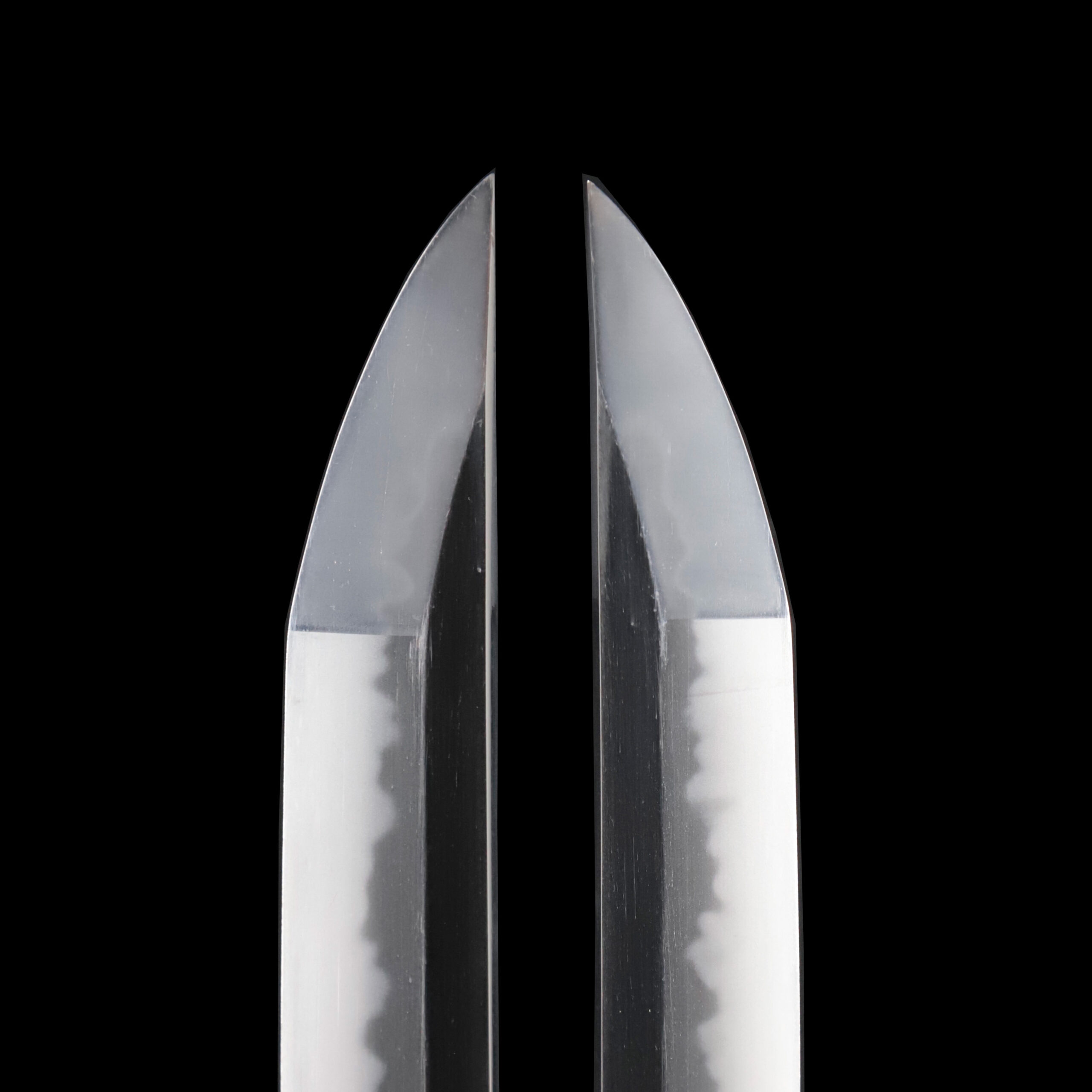
Nakago: Nakago is the tang of the Japanese sword.
Japanese swordsmiths left the black rust on the tang because it prevents red rust while the tang is in its handle. And the discoloration of the tang was created over time, and it is a great indicator for a Japanese sword specialist to estimate when the sword was forged.
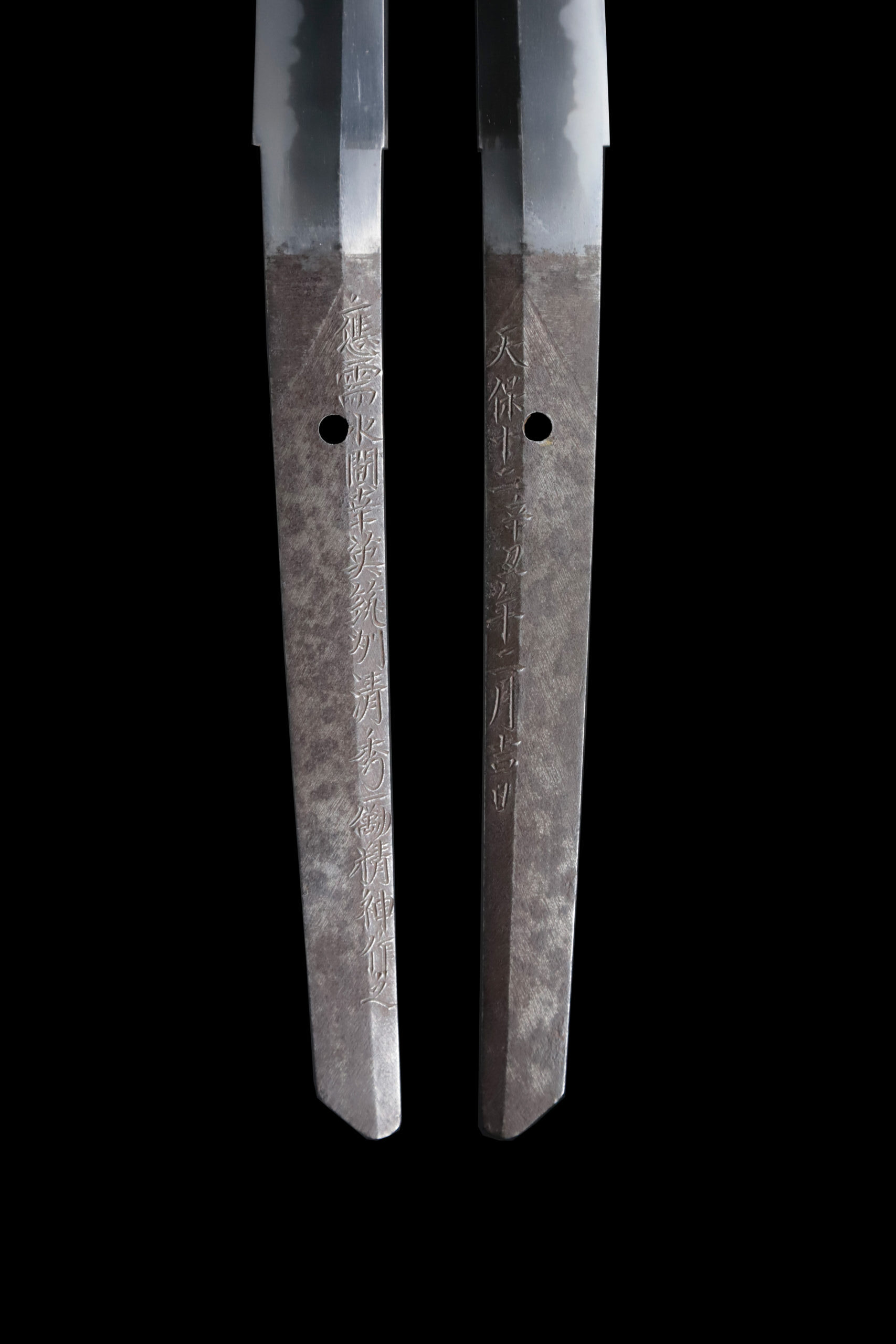
Koshirae: Koshirae is the mounting of the Japanese sword. There are several parts that consist of Koshirae such as Saya (Scabbard), Tsuka (Handle), Tsuba (Handguard).

Fuchi-Kashira: A pair of matching sword fittings that cover the upper and bottom parts of its sword hilt.
This Fuchi Kashira seems to be made from copper. Its surface is decorated with the Nanako-Ji (魚子地) technique. This process makes a uniform minimal protrusions pattern by hitting the Nanako-Ji Tagane (魚子地鏨, a chisel for this technique) on a metal surface. This decorative technique is often seen on sword mountings, as seen on this work.
You would find the figures of flying birds. While we are unsure what kind of birds they are, we estimate Kari (雁, wild goose) or Karasu (烏, crow) due to their appearance. The eyes and claws of the birds are painted gold. The wild goose is a migratory bird that represents autumn. Because of its unique call, it is known as “a bird that carries good luck and good news,” meaning that it carries a message with its ancestors and brings good news. This bird was incorporated into designs for sword mountings and family crests. We would say this bird motif has been familiar to Japanese people since ancient times. We would mention about crows in the Menuki’s description.
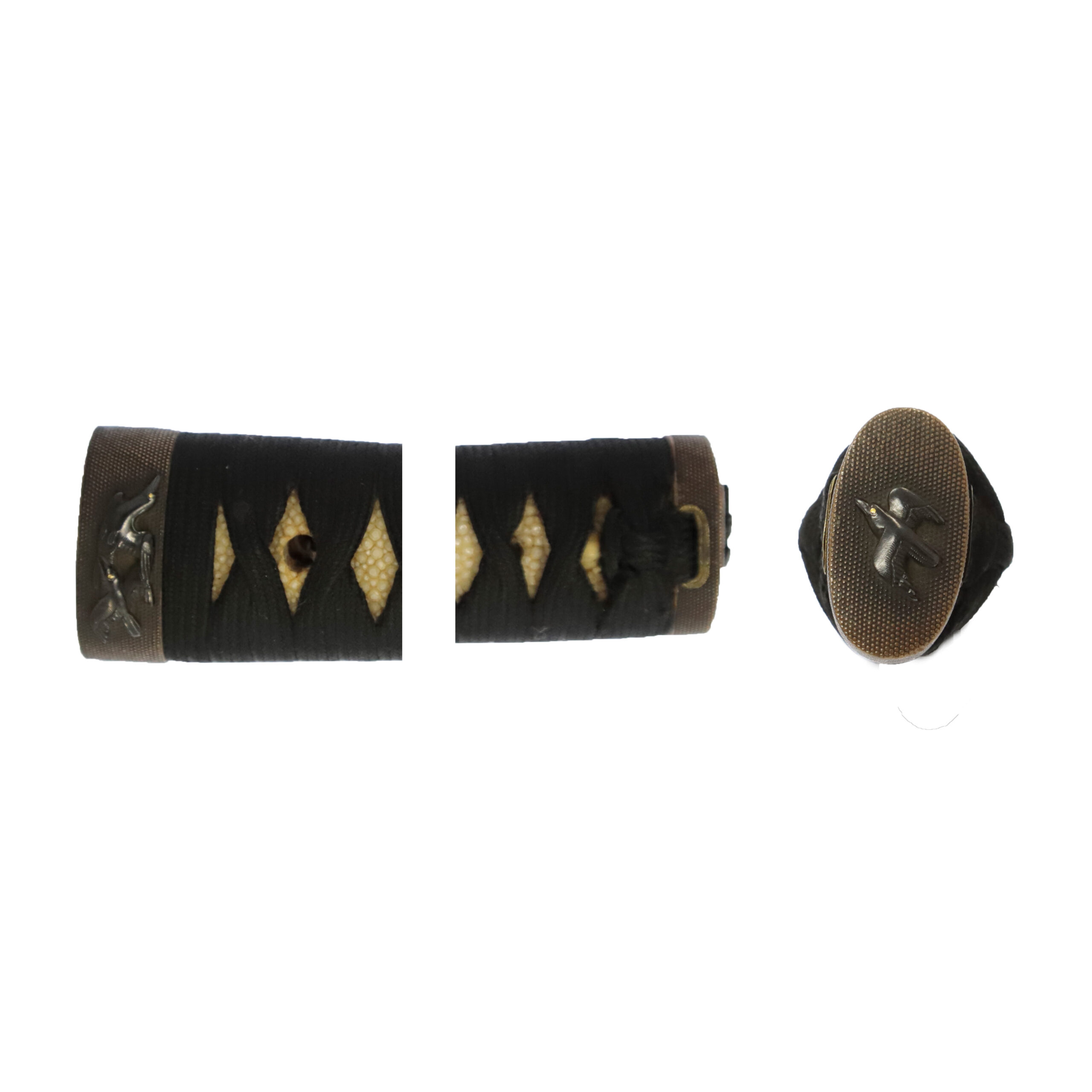
Tsuka and Menuki: Tsuka is the handle of the Japanese sword and Menuki is its decoration.
The same as the Fuchi Kashira, this Menuki is Crows are animals closely associated with solar worship. Ancient people believed that a three-legged bird lived in the sun. At a shrine where a crow is worshipped as a messenger of the gods, the three-legged crow represents heaven, earth (natural environment), and humans. This view says that God, nature, and humans are brothers born from the same sun.

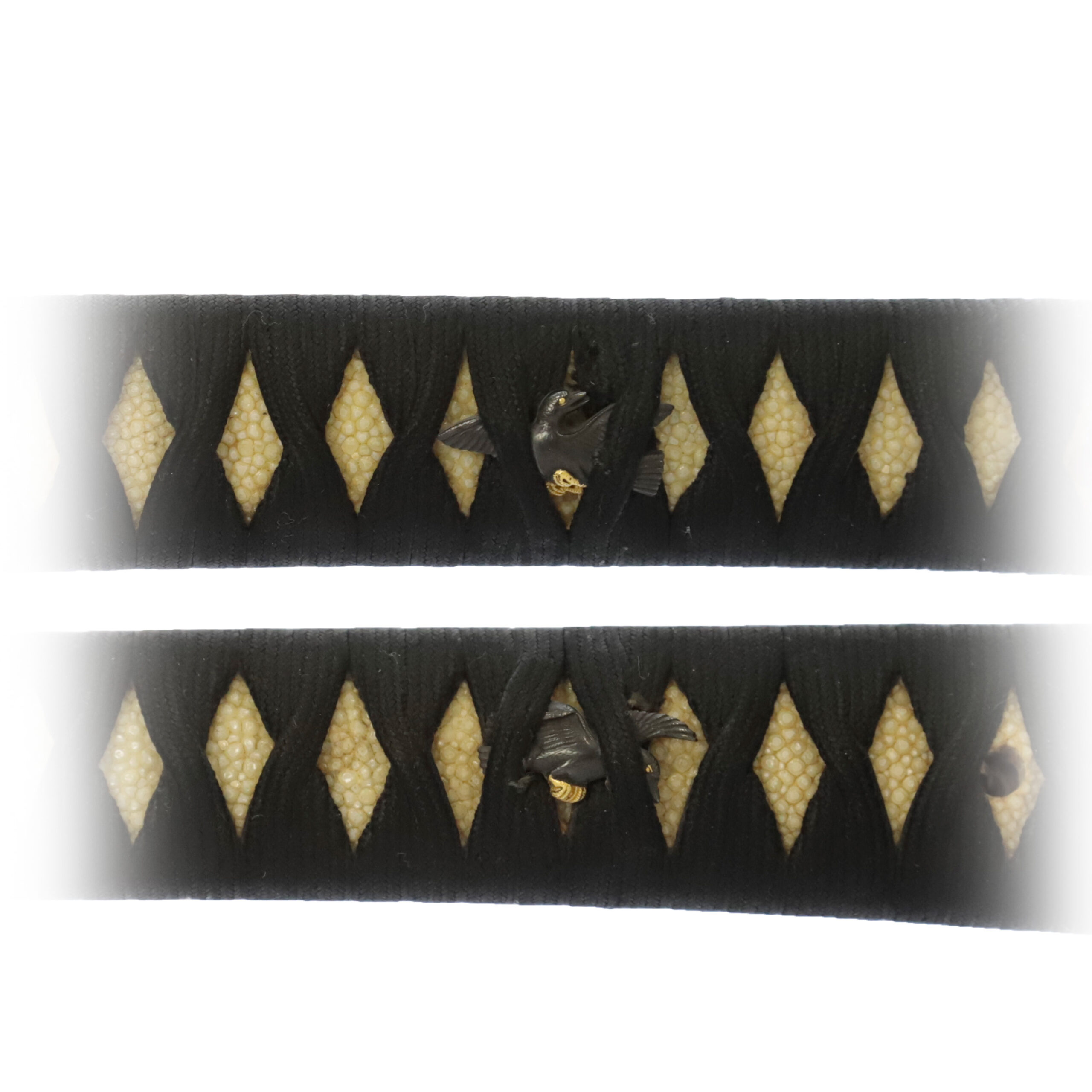
Tsuba and Habaki: Tsuba is the handguard for the Japanese Sword and Habaki is the equipment to make the blade not touch its scabbard inside. It prevents the blade from getting rusty and chipped.
This iron Tsuba has Yotsu-Mokkou (四ツ木瓜) shape. If you focus on the grounds of both sides, you will see a geometric pattern of rectangles engraved there. This design is a kind of Ajiro (網代) pattern, which is also called the Higaki (檜垣, a fence made of thin cypress boards with wickerwork). It is the design in which rows of oblique right and left rectangles are alternately combined. The intersection angle is not always a right angle, and the rectangle sometimes becomes a parallelogram. It is used for dyeing and weaving tint patterns and is also seen in bamboo works. The Ajiro is a wickerwork trap, fishing gear made of bamboo instead of a net. Therefore, this design represents a large catch. Also, some people believed it would exorcise evil spirits. These meanings might have inspired this Tsuba’s design.
The plants designed on this Tsuba are the Kiku (菊, chrysanthemum) flowers. One chrysanthemum flower is placed on each corner of this Tsuba. A long time ago, chrysanthemums were used as a medicine for obtaining a long life in the continent, and it was brought to Japan with this thought in the Nara period (648-781). The chrysanthemum symbolizes autumn, and people have greatly appreciated it since ancient times. The chrysanthemum has been likened to the sun as its petals form radially. That is why this flower pattern is treated as the symbol of perpetual youth and longevity or good health.
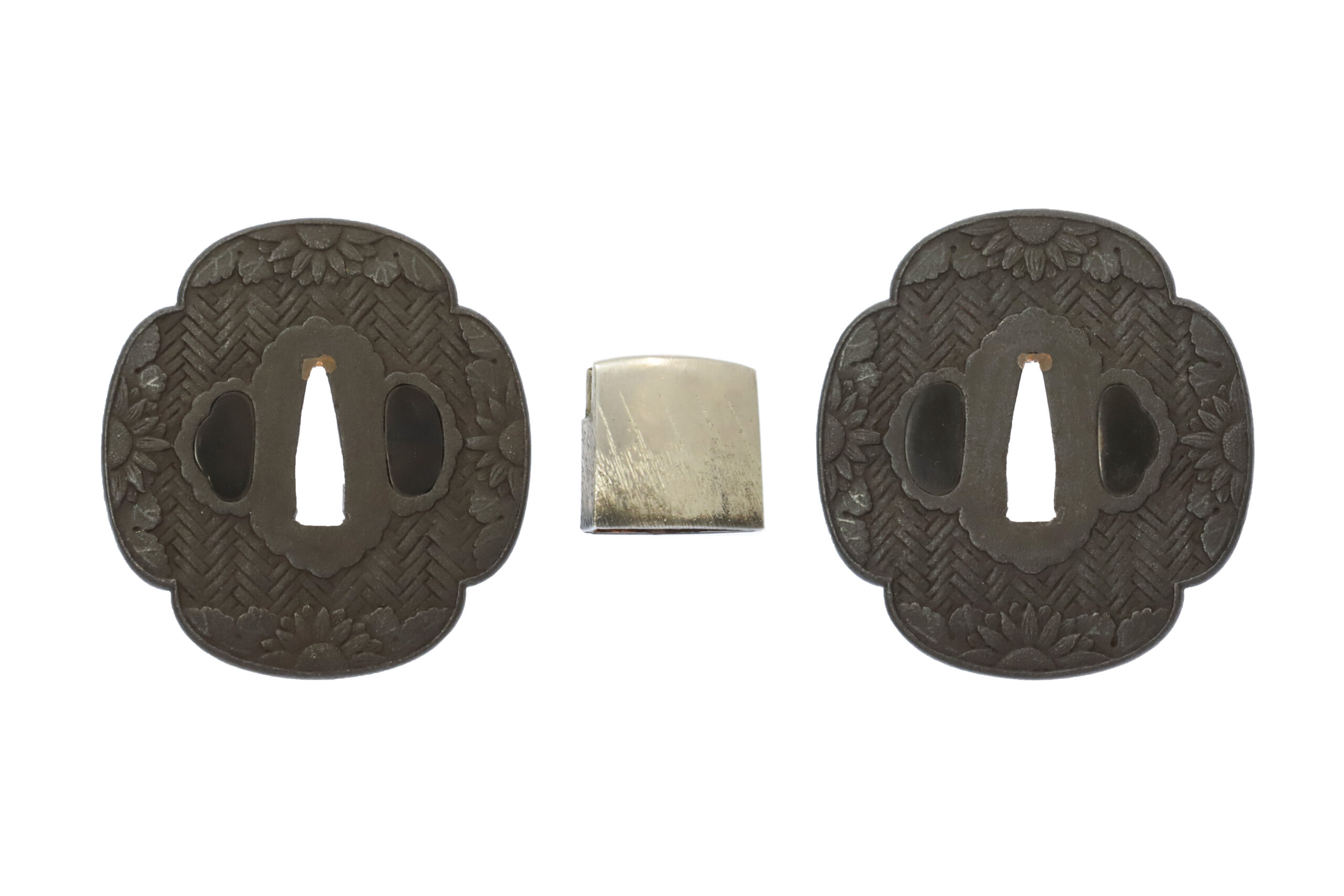
Saya: Saya is the scabbard for the Japanese sword.
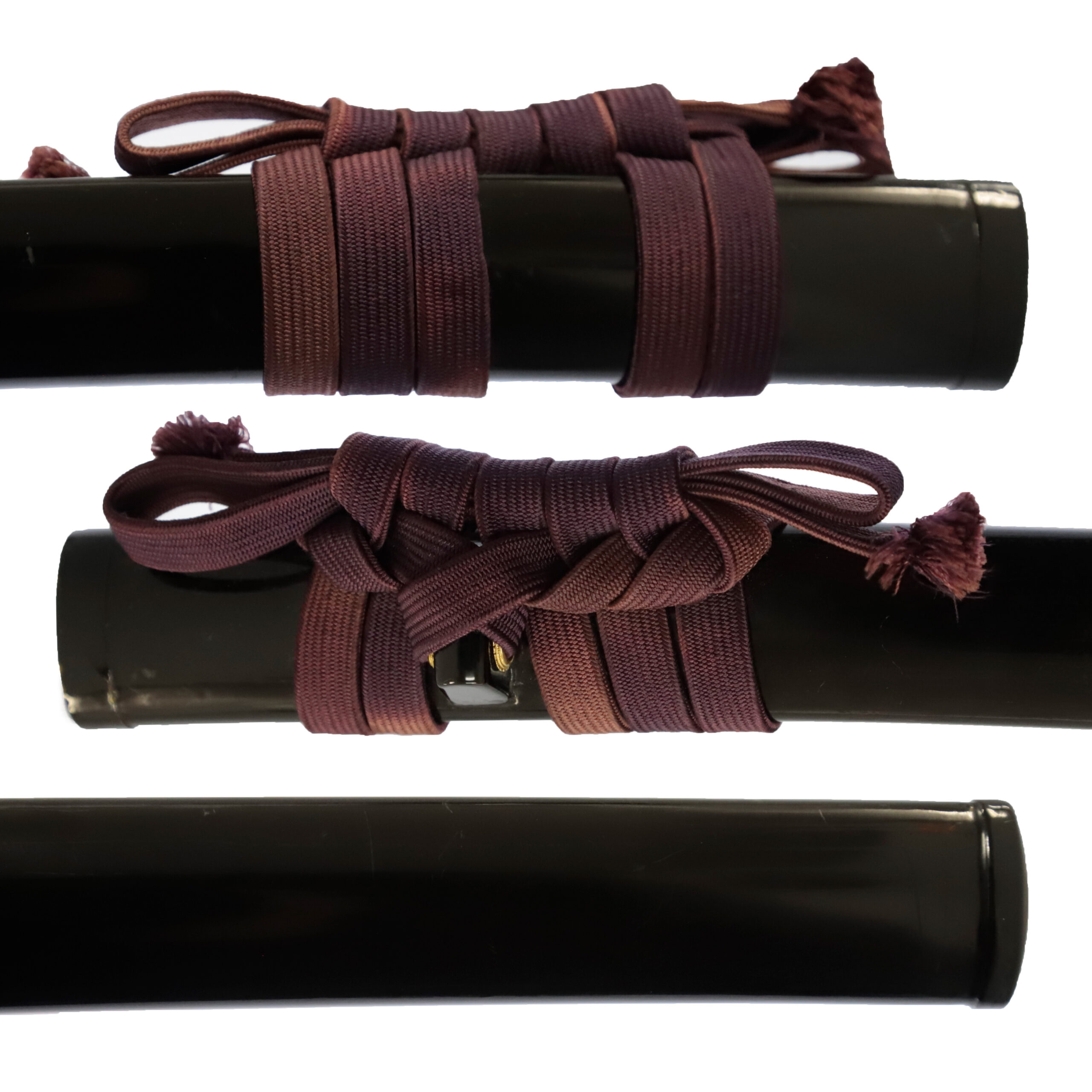
Authentication Paper: NBTHK TOKUBETSU Hozon Certificate for the blade (No. 1021759)
NBTHK, also known as Nihon Bijutsu Touken Hozon Kyokai (the Society for the Preservation of the Japan Art Sword), is one of the oldest Japanese sword appraising organizations in modern-day Japan. They authenticated the blade on Dec. 15th in the 5th year of Reiwa (2023). They appraised it as Tokubetsu Hozon Touken, the blade especially worth preserving for Japanese society. The purchaser will receive this original certificate as well. We can also translate what is written into English and make a PDF file for your record if you request.
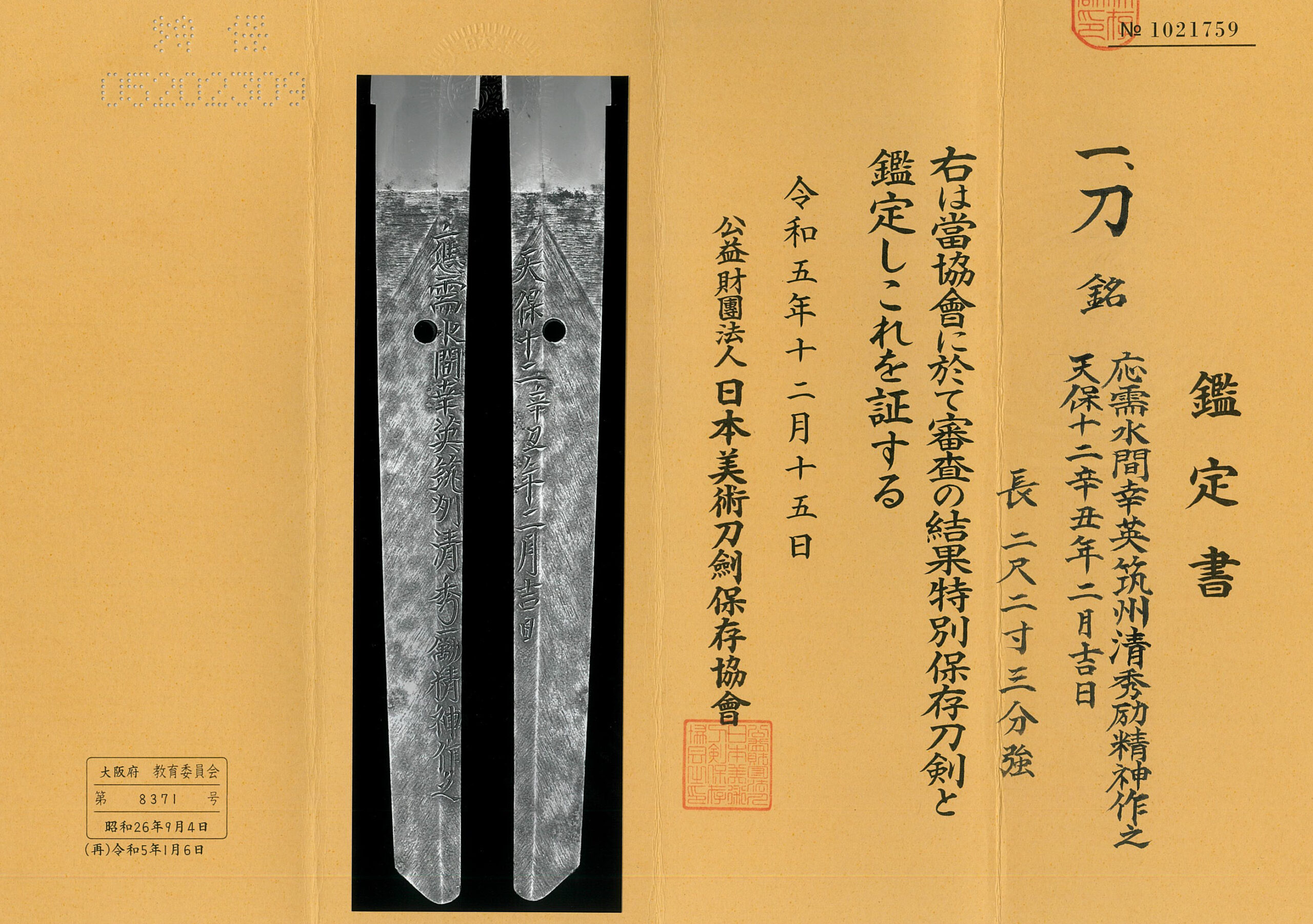
Registration Number: Osaka 8371
The Board of Education in Osaka prefecture issued a registration paper for this sword . It is called Jyu Hou Token Rui Torokusho (銃砲刀剣類登録証). Bunkacho (The Agency for Cultural Affairs) acknowledges a Japanese sword with this paper as a work of art.
The sword needs to be traditionally hand-forged and made of Tamahagane carbon steel to be registered in the system. With this paper, its owner in Japan can legally own an authentic Japanese sword. Based on this registration number, we will apply for its export permit.
This paper will need to be returned to the board of education when the sword is being shipped abroad, but you can receive a copy of it. An English translation of this registration paper is available on request.
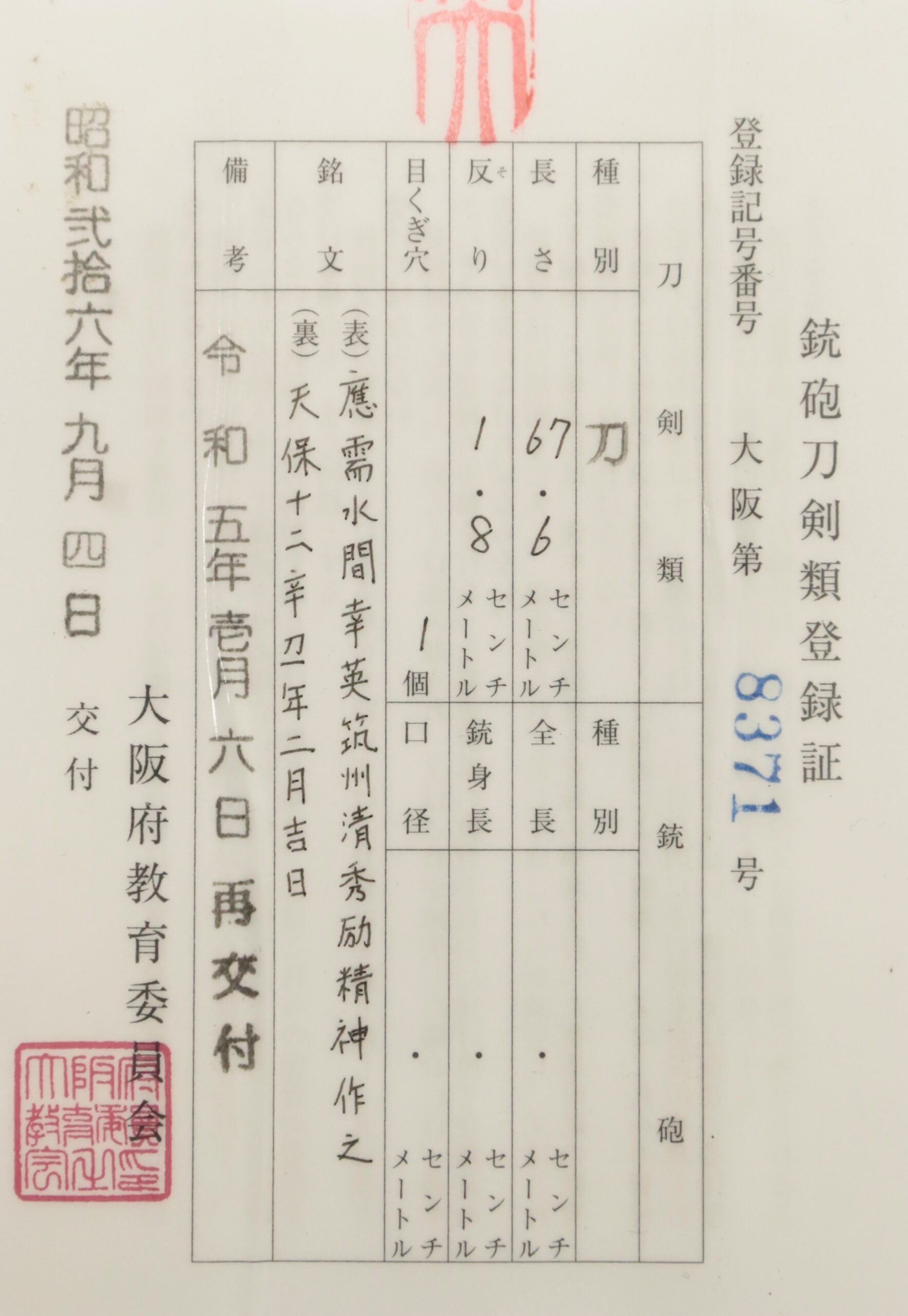
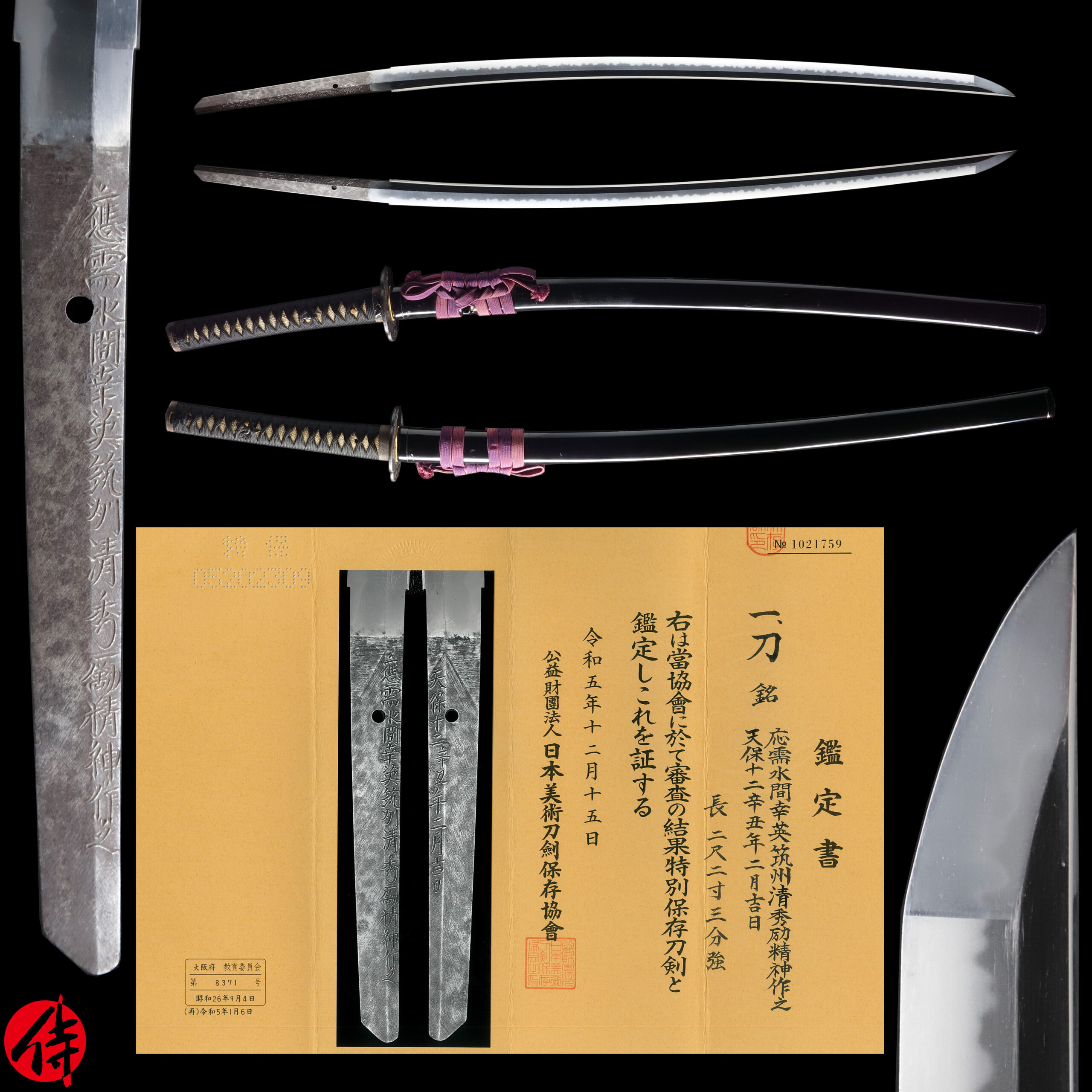
【About us】
Samurai Museum is located in Tokyo, Japan, exhibiting antique artifacts related to the Samurai history. Samurai Museum Shop is the place for those who are interested in Japanese culture and craftsmanship. We deal with antique Samurai swords/armor, traditional crafts made in Japan and so on.
【Japanese Sword& Export Process】
The Japanese swords we deal with are hand-forged edged swords made in Japan. It was made from the traditional carbon steel called TAMAHAGANE (玉鋼). Samurai Museum is familiar with the proper legal procedure for an antique/ authentic Japanese sword to be exported from Japan. We have sent more than 700 Japanese swords for the past few years (~2024) to amazing owners who appreciate its historical value.
Each Japanese sword is registered under the Agency for Cultural Affairs and the Board of Education in Japan. They issue a registration paper for each Japanese sword for its owner in Japan to legally possess it. The Japanese sword with its registration paper means it was traditionally hand-forged in Japan.
To legally export the sword from Japan to other countries, we will have to apply for its permit to the Agency for Cultural Affairs(Bunkacho) and return the original registration paper to the Board of Education. It normally takes around 2-4 weeks to receive this permit after submitting required documents. And we would like you to expect at least 1-1.5 months for your order to arrive at your given address after you ordered. For more detailed info, please click here.
It is allowed for residents in Japan to own authentic Japanese swords without a special license as long as they come with registration papers. Please feel free to contact us if you are a resident of Japan, whether temporarily or permanently. We will also assist you when you leave Japan and need to obtain the export permit.
【Payment Method】
We accept payment through Stripe (Credit card), PayPal, Apple Pay or ChromePay, all of which are secure payment methods. Also, you don’t need to make an account on Stripe for the checkout. If you prefer other payment method, please contact us. After confirming your payment, we will apply for an export permit. You may either pay in JPY, USD, AUD, CAD,EUR CHF or GBP. The price is set in Japanese Yen. Prices in other currencies are automatically calculated based on the latest exchange rate.

*If the amount is above 1 million JPY, Stripe or wire transfer will be the only options for payment.
【Shipping】
We have shipped authentic Japanese swords to the USA, UK, Canada, Mexico, Germany, France, Hong Kong and Australia. If you don’t live in these countries and like to order, please contact us first before making a purchase. We offer Free International Shipping as long as we can send antique Japanese swords by EMS.
We normally ship by EMS (Express Mail Service) provided by Japan Post. We will send you a tracking number for your order as soon as we hand it to the post office. We will put 100 % insurance on the shipping document without any extra charge. Based on the total amount, there might be a duty tax or other fee for you to pay, depending on the countries. We use package cushioning to protect the item and put it in a PVC pipe, which is one of the most secure packages because of its durability.
It will normally takes 5-14 days for the item to arrive at your given address after we dispatch it. Time of delivery is estimated as accurately as possible by the carrier but does not take into account any delays beyond our control such as by inclement weather, post office holiday seasons.
*If you live in Australia and like to purchase an authentic Japanese sword, please click here to know the detail.

【Review】
Here is one of the reviews we received from a customer who purchased an authentic Japanese sword from us. For more reviews, please click here.
“My experience overall with the whole process was wonderful. I had many questions about the history and process to purchase these treasures. All my questions were answered very timely and complete. The staff is very knowledgeable and very well versed if any questions do arise.”
【How to make sure the condition】
Please keep in mind that what you are going to purchase is an antique item. We uploaded high resolution photos for you to check its condition thoroughly. If you like to see more photos with different angles, please feel free to contact us. We will be happy to send them to you so that you can make informed decision. It is essential for us to know that you are happy with your choice of a sword. and we are prepared to use the best of our ability to serve you.
【How To Contact Us】
Please contact us through email, Facebook Messenger or Live Chat if you have any questions. You can find each icon on the right side of the website. Please click one of them to reach us. We will reply to you within 1-2 business days.
【The Art of Nihonto (Japanese Sword)】
Samurai’s history is a profound, eloquent legacy of ancient Japanese warriors in which millions of people worldwide are being fascinated. If you like to find out the art of Nihonto, please click here.
【A Guide to Japanese Sword Maintenance】
After acquiring an genuine Japanese sword, it is also important to know how to take good care of it. Here is the special video for you. Mr. Paul Martin, Japanese sword expert, shows you how to give proper maintenance to your sword. By mastering how to clean the Japanese sword, its aesthetic beauty will last forever.
When you purchase a Japanese sword from us, you can get a Free Japanese sword maintenance kit. It comes with four tools (Choji Oil, Uchiko Whetstone Powder, Peg remover, Oil Applicator). By watching the video instruction above , you can enjoy learning how to maintain your Japanese sword while appreciating it. If you have any difficulty assembling the sword or cleaning the blade, you can feel free to contact us.


MORE ANTIQUE JAPANESE SWORD FOR SALE
SWORDS WITHOUT CERTIFICATES FOR SALE
LEARN JAPANESE SWORD TERMINOLOGY
Thank you for reading all the information on the page. If you have any difficulty choosing the right Japanese sword for you, we will be more than happy to help you find the one that speaks to you the most. Please feel free to contact us.
